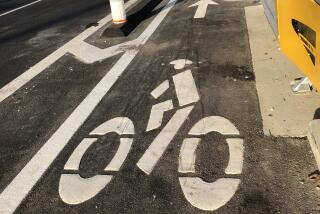A path to awareness on a single speed
- Share via
Yes, SOME FADS ARE too good to let pass.
So I’m spinning down the San Gabriel River trail on a new single-speed bike, an all-purpose retro runabout, a cyclocross in biking vernacular, with oversize tires that soak up the path’s roughness and 1980s moustache handlebars that keep me sitting upright where I can enjoy the passing scene.
The machine offers no leverage against wind or gradient, heightening the rider’s awareness of both -- which, of course, was the point.
Getting to this point, though, took some doing. My initial experiment in single-speeding, a bike built with ordinary components, splattered me on the pavement. Without warning, the chain flew off the sprockets when I mashed on the pedals, leaving behind a residue of skin, blood and deflated ego.
I consulted experts and began with a second, single-speed specific bike.
The problem? Most of the best modern bicycles are engineered to facilitate delicate shifting. Chain tension is maintained by the spring of the derailleur. Eliminating the derailleur leaves a bike with the latent, hair-trigger urge to shift on its own under pressure.
On a single-speed, the chain has nowhere to launch but into the air. Next stop may be your dentist or orthopedist.
Surly Bikes, the Minnesota specialty company that manufactured my frame, and Karl Hasenjaeger of the Path bike shop in Tustin, who assembled the components, offered these suggestions for those intent on vigorous riding:
The chain must be pulled reasonably tight and kept that way. Bikes with modern vertical dropouts for rear axle attachment need to be fitted with specialty parts or worked over by a knowledgeable mechanic. Single-speed setups are more compatible with semi-horizontal or track-style horizontal dropouts that permit precise chain adjustment.
Beyond that, the safest arrangement combines a bolt-on rear hub specifically designed for gearless riding, along with sprockets front and rear that have not been machined, pinned or ramped for shifting. A track or BMX chain, aligned to run perfectly straight between sprockets, rounds out the rig.
With those alterations, my single-speed now glides down the path as silent as a shadow. I slow to see herons tiptoeing and posing in the shallows. Later I am conscious of where the river bottom has been territorially claimed by pelicans. Beyond them, cormorants. Egrets, with handlebar necks, alight where they find space. When the sun is right, I watch schools of fish in this once wild and wandering ditch.
Nearing the ocean, the concrete banks of the river yield to rocks and stands of reeds that can almost be called lush. Then the paltry flow of foothill-and-yard runoff disappears into the tidewater flat, a convergence that may someday give root to mangroves, but not yet.
Occasionally there is an odd detergent smell to the river, blending strangely with the spices of sea breeze.
We have choices. Do we ride with gears or gearless? Do we see an urban trench or do we see vibrant nature? Do we hear the nearby heron or the distant honk of horns? Do we buy into the mythology of single-speed minimalism, where the workings of the bicycle occupy less of one’s concentration and the surroundings more? If that is what you seek, it can be realized. With a little work.
-- John Balzar






